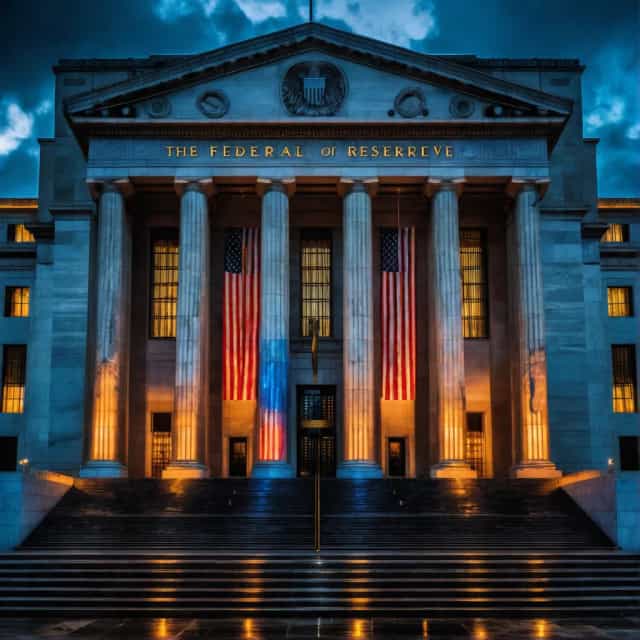
Image source: Block Media
Federal Reserve Cuts Interest Rates Amid Labor Market Slowdown, Signals Additional Cuts This Year
The Federal Reserve took decisive action on Wednesday by lowering interest rates amid growing concerns over a weakening U.S. labor market. Additionally, the central bank signaled its intention to implement two further rate cuts before the year ends, reflecting a strategic response to mounting economic uncertainties.
Federal Reserve Reduces Rates in Majority Decision
In a near-unanimous decision, the Federal Open Market Committee (FOMC) voted 11-to-1 to reduce the federal funds rate by 0.25 percentage points, adjusting the benchmark range to 4.00%–4.25%. The lone dissenting vote came from board member Stephen Miran, who pushed for a more aggressive 0.5-percentage-point reduction. This decision, while expected by analysts, sheds light on both the Fed’s cautious approach and internal differences regarding the pace of monetary easing.
The modest nature of the cut reflects a tempered response to intensifying headwinds in the U.S. economy, yet highlights the central bank’s readiness to act further should economic conditions deteriorate.
Balancing Labor Market Challenges and Inflation Pressures
In a carefully worded post-meeting statement, the FOMC outlined dual challenges facing the economy: a slowdown in employment growth and persistently elevated inflation levels. The committee noted that economic activity has “weakened” and introduced new language underscoring that "employment growth has slowed." Meanwhile, inflation has “risen” and remains above desirable levels, posing conflicting challenges to the Fed’s dual mandate of fostering price stability and ensuring maximum employment.
Federal Reserve Chair Jerome Powell addressed these complexities during a press conference, emphasizing the unprecedented nature of the current situation. “The noticeable slowdown in both labor supply and demand in a less dynamic and somewhat softer labor market is unusual,” Powell remarked, adding, “Downside risks to employment appear to have increased.” This signals the Fed’s awareness of emerging vulnerabilities in the job market while grappling with an inflationary environment that has proven more stubborn than initially hoped.
Dot Plot Reveals Expectation of Two Additional Rate Cuts in 2023
A key highlight of the FOMC meeting was the updated "dot plot," which charts individual policymakers’ interest rate projections. The latest projections indicate a likelihood of two additional rate cuts before the end of 2023, potentially aligning with the October and December meetings.
However, significant divergence was evident among participants, reflecting varying opinions on the appropriate path forward. Notably, one dot—suspected to belong to Stephen Miran—hinted at a substantial additional cut of 1.25 percentage points this year. Among the 19 policymakers, 10 anticipated two further cuts, while nine expected only one more.
The dot plot, submitted anonymously, provides an illuminating snapshot of internal Fed dynamics and underscores the committee’s range of views as it navigates an uncertain economic landscape.
Political Tensions and the Fed’s Independence
The Fed’s actions occur against a backdrop of rising political pressure, with President Donald Trump emerging as a vocal critic of the central bank's policies. Trump has consistently called for more aggressive rate reductions, claiming they are vital to reinvigorating the sluggish housing market and alleviating the cost of financing government debt. The appointment of Stephen Miran—a notable advocate for deep rate cuts—to the Fed board further underscores the administration’s influence.
Trump’s criticisms have raised questions about the Fed’s independence, a cornerstone of its credibility and effectiveness. Powell reiterated this independence during the meeting, countering calls for more drastic measures by affirming that there was “no broad support” within the committee for a 0.5-percentage-point rate reduction. His statement reflects a commitment to pursuing a balanced, data-driven approach to monetary policy while resisting overt political interference.
Navigating a Delicate Economic Balance
The Federal Reserve faces an intricate balancing act as it works to uphold its dual mandate in the face of slowing labor market growth and persistently high inflation. By opting for a measured 0.25-percentage-point reduction and signaling further action if necessary, the Fed demonstrates cautious adaptability amid economic challenges.
While responding to external pressures, including heightened political scrutiny, the central bank continues to navigate between maintaining its independence and addressing evolving economic risks. The coming months will likely test the Fed’s ability to address these complex dynamics as it implements the anticipated rate adjustments while striving to support economic stability.










